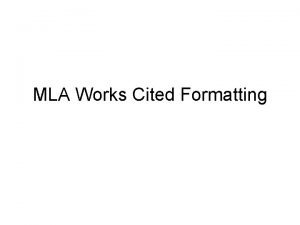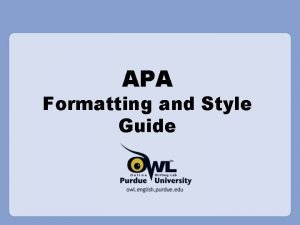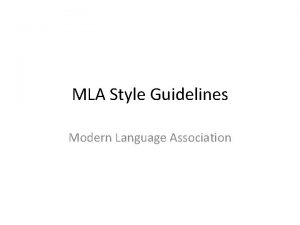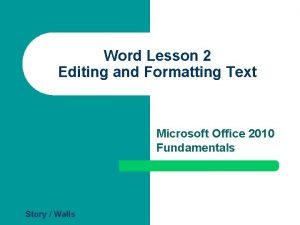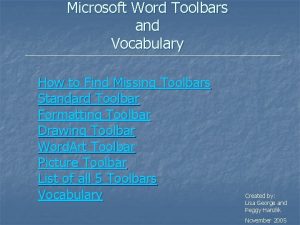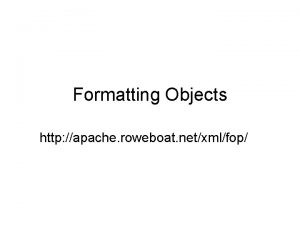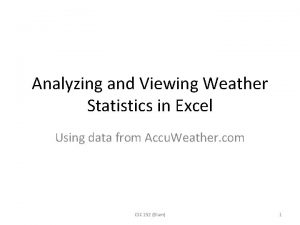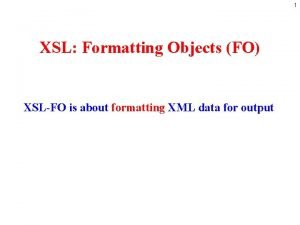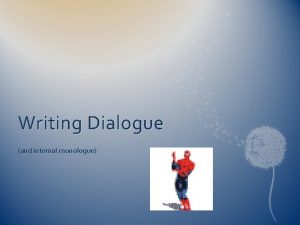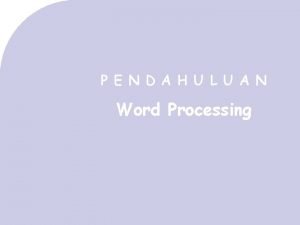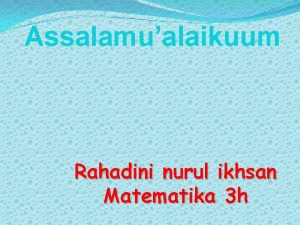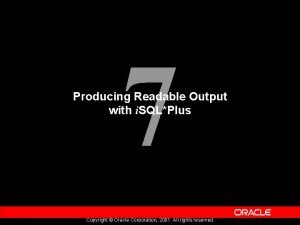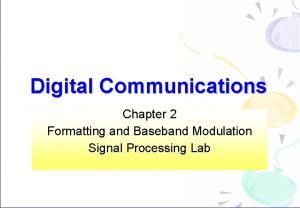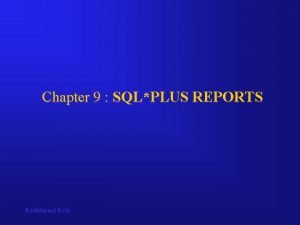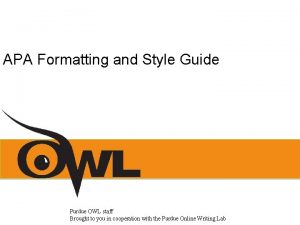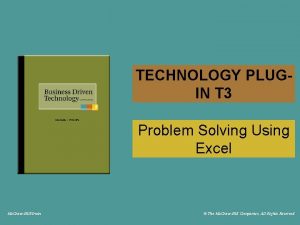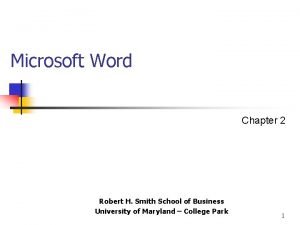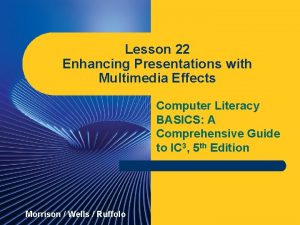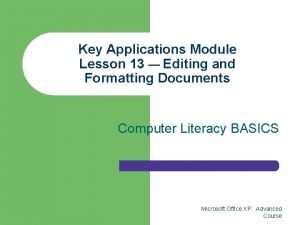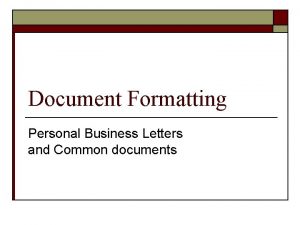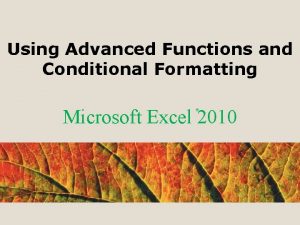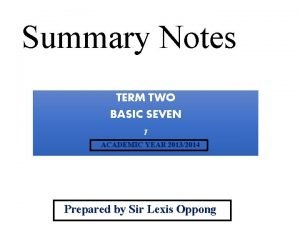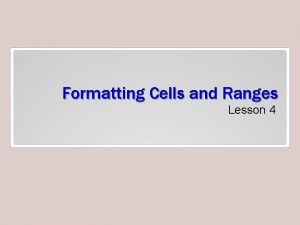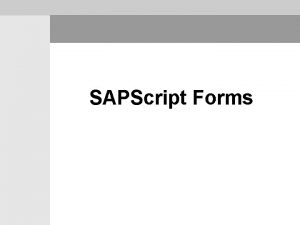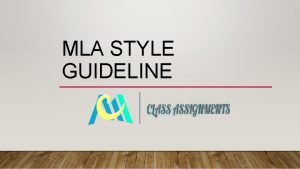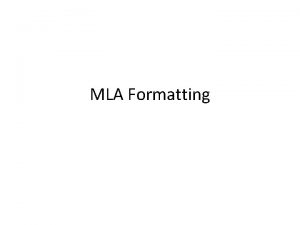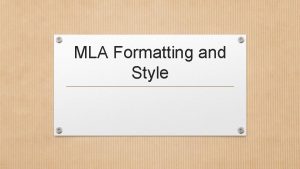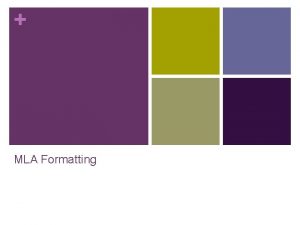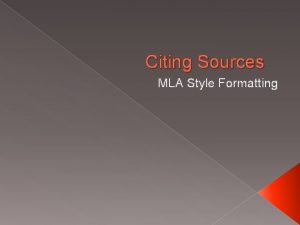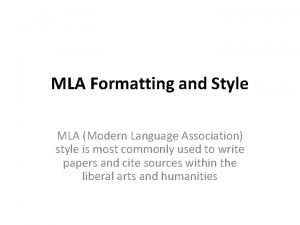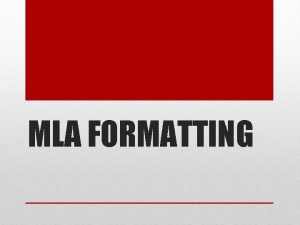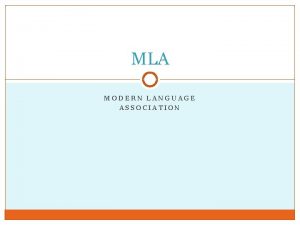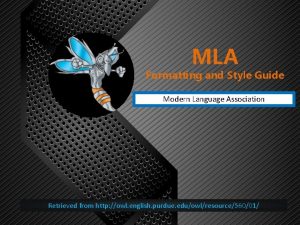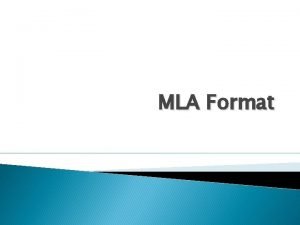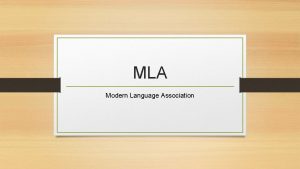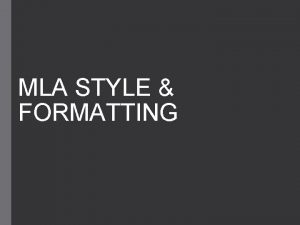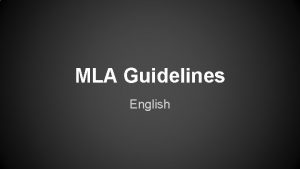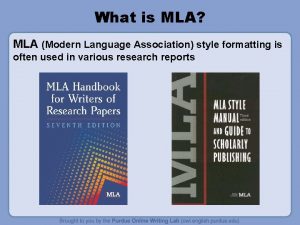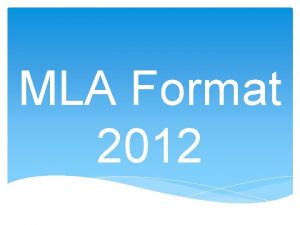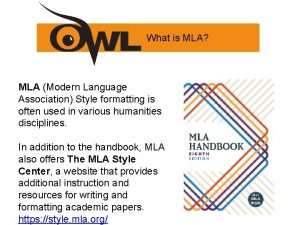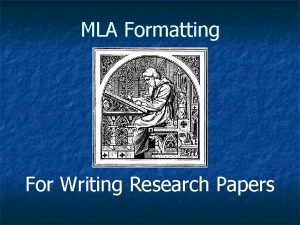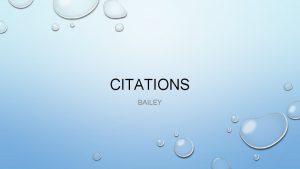MLA Formatting What is MLA Style Modern Language































- Slides: 31

+ MLA Formatting

+ What is MLA Style? Modern Language Association style (MLA) referencing A set of rules and guidelines to standardize . This style is most commonly used in the Liberal Arts and Humanities. Standards apply to the formatting of your essay, in-text citations and your works cited page. There are Three main components: 1. Formatting 2. In-text Citations 3. Works Cited Page

+ Citing & Formatting: why bother? n By using a standard, discipline-specific style, we accomplish a number of things: n Save time by having a pre-designed method to present certain information n Allow our readers to quickly scan our papers for certain information n Establish credibility (appeal to ethos!) n Avoid plagiarism n https: //www. youtube. com/watch? v=e. DI 0 Fdt. Bl. HE

+ Formatting: why bother? n MLA assignment (5%) n Third Paper n Research Paper n All your other courses!

+ Again, what is MLA Style? There are Three main components: 1. Formatting 2. In-text Citation 3. Works Cited Page

+ 1. Formatting – title page No title page using MLA style!

Use “page number” in the Insert tab and use last name Student Name Professor Name Course Code Date Submitted (day month year) Centred Title Indented text starting the body of your essay. All text in your paper using MLA style should be 12 -point, Times New Roman font. Everything should be double spaced. You should be using 1 -inch margins.


+ 2: In-Text Citations PURPOSE: 1. 2. Acknowledges the material you have acquired from other authors (avoids plagiarism) – for direct quotations AND paraphrasing Points reader to your Works Cited page

+ 2: In-Text Citations Rule 1 Use the “author-page number” method of citation if you are citing a direct quote or paraphrasing an idea. Do NOT include an abbreviation for page number (Jones pp. 3 -4) Similarly, the lectures Thomas Carlyle gave under the general heading of heroes and hero worship in 1840 that were published in the collection that became known as Carlyle’s Heroes went through twenty-eight English and twenty-five American editions in the next 60 years (Niemeyer 67).

+ 2: In-Text Citations Rule 2: If you introduce the name of the author in your quote, you only need the page number There exists in the fallen post-apocalyptic world of The Walking Dead a sometimes murky rearrangement of class relationships. It might seem odd to consider class when capitalist employment has been, in large part, eradicated, but, as Marx and Engels claimed, “The history of all hitherto existing society is the history of class struggles” (3).

+2: In-Text Citations Rule 3: For multiple authors: - use “and” (Marx and Engels 8) - for sources with three or more authors, use only the first author’s last name and replace the rest with “et al. ” (Marx, et al. 8) There exists in the fallen post-apocalyptic world of The Walking Dead a sometimes murky rearrangement of class relationships. It might seem odd to consider class when capitalist employment has been, in large part, eradicated, but, according to Marxist theory, “The history of all hitherto existing society is the history of class struggles” (Marx and Engels 3).

+ 2: In-Text Citations Rule 4: If you are using multiple sources from an author, you use the name of the specific work instead of the author’s name. Murphy writes of the modern home that it is, “not the impregnable stronghold that we mentally visualize from literature, or which has been handed down in the lore of the Saxons” (Black Candle 305).

+ 2: In-Text Citations Rule 5: If you are using the a source that you have already introduced by last name, you don’t need to use the name again. Similarly, the lectures Thomas Carlyle gave under the general heading of heroes and hero worship in 1840 that were published in the collection that became known as Carlyle’s Heroes went through twenty-eight English and twenty-five American editions in the next 60 years (Niemeyer 67). Carlyle focused on the great men of history, the kings, prophets, and great poets, but there is a definite “democratic” turn to his thoughts. Napoleon, “our last Great Man!” with whom Carlyle concludes his meditations, is described as a “true Democrat” only deterred from his goal of creating a state for the people by “the fatal charlatan-element” that steered him towards dreams of dynasty (240 -243).

+ 2. In-Text Citation Rule 6: If you are using one source and then switch to another, you need to include the author or title. If you switch back to that first source, you then need to introduce it again. Murphy writes of the modern home that it is, “not the impregnable stronghold that we mentally visualize from literature, or which has been handed down in the lore of the Saxons” (Black Candle 305). If left unsupervised by white authority for but a short time, will fall prey to an awaiting assemblage of non-white “sharks” (303). In her use of natural imagery, Murphy describes a system that, while depending upon racist stereotypes and what Stoler calls the “subjunctive mood of official imaginings. . . narratives not about what might have been. . . but more about what might yet be (Archival Grain 106), places the power squarely in the hands of the white mothers. Yet, Murphy is highly critical of these same mothers. In her tale of a teenage girl brought home from one of the city’s dreaded “chop-suey houses, ” Murphy describes the mother as so negligent that she voices no concern for her daughter’s well-being only her annoyance at being roused at “so unearthly an hour” (Black Candle 304).

+ 2. In-Text Citation Rule 7: For a work with no author (this includes many web pages and corporate and governmental publications), use the title of the source, and abbreviate it if it is long According to one source, “Our reptilian overlords love to eat flies —so if you want to held in high esteem by our new masters, make sure you stock up” (“Reptilian Overlords” 8)

+ 2. In-Text Citation Rule 8: For online sources with no pagination, you use only the last name or title of the article. According to one source, “Our reptilian overlords love to eat flies —so if you want to held in high esteem by our new masters, make sure you stock up” (Johnston).

+ 3. Works Cited Title Author, A. Title. Place of Publication: Publisher. In-Text Citation Works Cited Page As some would contend, “quote quote quote “ (Author, 9). YOU MUST HAVE BOTH

+ 3. The Works Cited Page • Contains full bibliographic information • Includes all of your sources • Organized in alphabetical order (followed by alphabetical order for multiple entries from the same author(s)) • Each entry has a hanging indent. That means that every line but the first of each entry is indented • Use full first names • Italicize titles of books and periodicals but not articles and other shorter works • Entries are not numbered, they are listed in alphabetical order.


+ 3. The Works Cited Page The 8 th edition of the MLA guide has a simplified system. n Author. n Title of source. n Title of container, n Other contributors, n Version, n Number, n Publisher, n Publication date, n Location can refer to the page numbers in the book if you are referring to a specific section (i. e. an essay in your textbook), but it also covers the URL of a website or the physical location of a work of art.

+ 3. The Works Cited Page Book with single author: Devereux, Cecily Margaret. Growing a Race: Nellie L. Mc. Clung and the Fiction of Eugenic Feminism. Mc. Gill-Queens UP, 2005. Book with multiple authors: Devereux, Cecily Margaret and Ian Jones. Growing a Race: Nellie L. Mc. Clung and the Fiction of Eugenic Feminism. Mc. Gill-Queens UP, 2005. Work collected in an edited book: King, Stephan. “Why We Crave Horror Movies. ” Readings for GASC 200: Academic Writing. Nelson, 2013, pp. 113 -116.

+ 3. The Works Cited Page Multiple works by a single author: Stoler, Ann Laura. Along the Archival Grain: Epistemic Anxieties and Colonial Common Sense. Princeton UP, 2009. ---. Race and the Education of Desire. Duke UP, 1995. Work in a scholarly journal: Kulba, Tracy. “Citizens, Consumers, Critique-al Subjects: Rethinking the “Statue Controversy” and Emily Murphy’s Black Candle (1922). ” Tessera, vol. . 31, 2001– 2, pp. 74 -89.

+ 3. The Works Cited Page An online work: Bernstein, Mark. "10 Tips on Writing the Living Web. " A List Apart: For People Who Make Websites, 16 Aug. 2002, alistapart. com/article/writeliving. Accessed 4 May 2009. Wheelis, Mark. "Investigating Disease Outbreaks Under a Protocol to the Biological and Toxin Weapons Convention. " Emerging Infectious Diseases, vol. 6, no. 6, 2000, pp. 595600, wwwnc. cdc. gov/eid/article/6/6/00 -0607_article. Accessed 8 Feb. 2009.

+ Online Resources n https: //owl. english. purdue. edu/owl/section/2/

+ n. Try some on your own!

+ The Book of Unknown Americans n Christina Henriquez n 2014 n Vintage Books

+ Henriquez, Christina. The Book of Unknown Americans. Vintage, 2014.

+ “Why Privacy Matters Even If You Have ‘Nothing to Hide’. ” n Daniel J. Solove n Bedford/St. Martin’s n pp. 163 -167 n The Concise St. Martin’s Guide to Writing n 7 th ed. n 2015 n Ed. Rise B. Axelrod & Charles R. Cooper

+ Solove, Daniel J. , “Why Privacy Matters Even If You Have ‘Nothing to Hide’. ” The Concise St. Martin’s Guide to Writing. Ed. Rise B. Axelrod & Charles R. Cooper, 7 th ed. , Bedford/St. Martin’s, 2015. pp. 163167.

+ Works Cited Henriquez, Christina. The Book of Unknown Americans. Vintage, 2014. Solove, Daniel J. “Why Privacy Matters Even If You Have ‘Nothing to Hide’. ” The Concise St. Martin’s Guide to Writing. Ed. Rise B. Axelrod & Charles R. Cooper, 7 th ed. , Bedford/St. Martin’s, 2015. pp. 163 -167.
 Mla works cited owl
Mla works cited owl What is apa formatting style
What is apa formatting style Open punctuation style letter example
Open punctuation style letter example Modern language association mla format
Modern language association mla format New document word
New document word Apa format cover page
Apa format cover page How to word
How to word Apache fop
Apache fop Weather in excel
Weather in excel Formatting objects processor
Formatting objects processor Internal dialogue in writing examples
Internal dialogue in writing examples Gambar toolbar formatting
Gambar toolbar formatting Data organization and formatting of magnetic disk
Data organization and formatting of magnetic disk Gambar toolbar formatting
Gambar toolbar formatting Sqlplus format output
Sqlplus format output Which microsoft word tab contains the print command? *
Which microsoft word tab contains the print command? * Mla quotation marks and punctuation
Mla quotation marks and punctuation Formatting in digital communication
Formatting in digital communication Sqlplus report formatting
Sqlplus report formatting Apa citation purdue
Apa citation purdue Pascal writeln formatting
Pascal writeln formatting Text box formatting
Text box formatting Paragraph formatting
Paragraph formatting Paragraph formatting
Paragraph formatting Text box formatting
Text box formatting Paragraph formatting
Paragraph formatting Formatting business documents
Formatting business documents Microsoft excel conditional formatting
Microsoft excel conditional formatting Formatting toolbar
Formatting toolbar Pascal writeln formatting
Pascal writeln formatting A named group of formatting characteristics
A named group of formatting characteristics Sapscript define
Sapscript define
